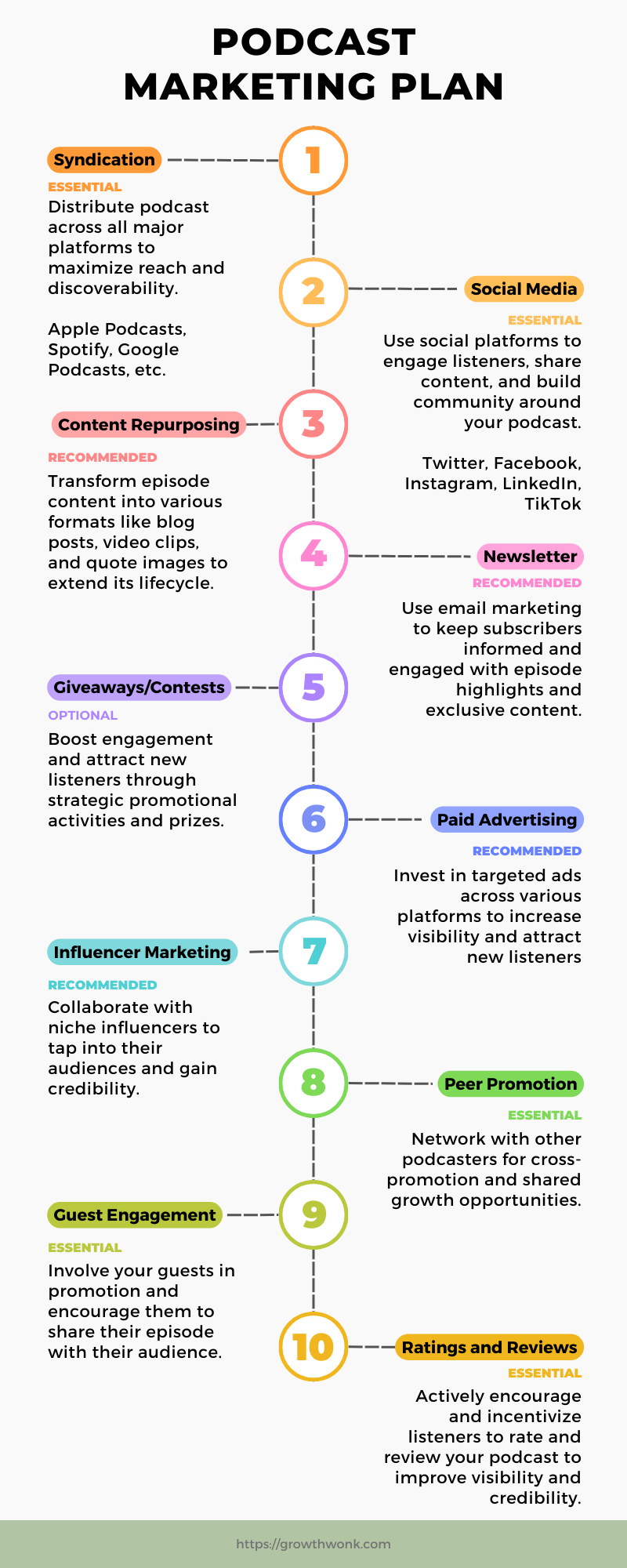In this article, we’ll explore ten key elements of a successful podcast marketing plan, each rated for its importance in your overall strategy. We’ve got you covered from essential syndication tactics to optional contest ideas.
We’ll also present a clear infographic that visualizes how these elements interconnect to create a thriving podcast ecosystem.
The Ultimate Podcast Marketing Plan
Let’s discover how to take your podcast from a hidden gem to a must-listen sensation!
1. Podcast Syndication
Submit your podcast to major directories such as Apple Podcasts, Spotify, Google Podcasts, and Stitcher. This will make it easier for potential listeners to find and subscribe to your show.
Here’s a table outlining the major podcast platforms with their priority for syndication:
| Platform | Priority | Notes |
|---|---|---|
| Apple Podcasts | High | Largest audience reach |
| Spotify | High | Growing rapidly in the podcast space |
| Google Podcasts | High | Good for Android users |
| Stitcher | Medium | Popular among podcast enthusiasts |
| TuneIn | Medium | Good for smart speaker integration |
| Pandora | Medium | Large music audience transitioning to podcasts |
| iHeartRadio | Medium | Large radio audience |
| Overcast | Low | Popular among iOS power users |
| Pocket Casts | Low | Dedicated podcast app with loyal user base |
| Castbox | Low | Growing international audience |
2. Social Media Promotion
Utilize social media platforms to promote your podcast and engage with your audience. Create a content calendar to schedule posts across various platforms such as Facebook, Twitter, Instagram, and LinkedIn. Share teaser clips, behind-the-scenes content, and episode updates to keep your followers interested and informed.
The following is a breakdown of the different types of content you can share on different social media accounts:
| Platform | Content Type |
|---|---|
| Short quotes, polls, behind-the-scenes photos | |
| Longer form posts, event announcements, community discussions | |
| Visually appealing quotes, guest photos, story highlights | |
| Professional insights, industry news related to podcast topics | |
| TikTok | Short, engaging video clips from episodes or behind-the-scenes |
| YouTube | Full video episodes (if applicable), trailers, highlight reels |
3. Content Repurposing
Repurposing your podcast content across different mediums can help reach a wider audience and drive engagement. Consider turning episodes into blog posts, creating audiograms for social media, or even repackaging content into an email newsletter.
By diversifying the formats in which your content is shared, you can cater to different preferences and behaviors of your audience.
The below table outlines a content repurposing plan, detailing the types of content to be produced, the platforms where they should be published, the frequency of their release, and their intended purposes.
| Content Type | Platform | Frequency | Purpose |
|---|---|---|---|
| Blog Posts | Website | 1 per episode | SEO, in-depth exploration |
| Video Shorts | YouTube, TikTok, Instagram Reels | 2-3 per episode | Engagement, discovery |
| Audio Clips | Instagram, Twitter, Facebook | 3-5 per episode | Teasers, highlights |
| Quote Images | All social platforms | 5-7 per episode | Shareable content, wisdom nuggets |
| Newsletter Inclusion | Every episode | Subscriber engagement | |
| Transcript | Website | Every episode | Accessibility, SEO |
4. Newsletter
Use email marketing to keep your audience engaged and informed about your podcast. The newsletter serves as a direct line of communication with your email list, allowing you to share content beyond what’s in your episodes.
Here’s a breakdown of how to effectively include your podcast in a newsletter:
- Episode summaries: Provide brief overviews of recent episodes, highlighting key points or interesting quotes. This reminds subscribers of episodes they might have missed and entices them to listen.
- Behind-the-scenes content: Share exclusive information about your podcast production process, upcoming guests, or personal insights. This creates a sense of insider access for your newsletter subscribers.
- Subscriber-only bonus content: Offer additional content related to your episodes that’s only available to newsletter subscribers. This could include extended interviews, additional resources, or exclusive Q&A sessions.
- Promote upcoming episodes and guests: Generate anticipation by teasing future content. This can include revealing upcoming guest names, discussing future topics, or sharing snippets from episodes in production.
- Call-to-action: Include clear CTAs in your newsletter, encouraging subscribers to listen to the latest episode, leave a review, or share the podcast with friends.
- Listener feedback: Feature comments or questions from listeners, fostering a sense of community and encouraging more engagement.
- Related content: Share articles, videos, or other media related to your podcast topics, providing additional value to your subscribers.
5. Giveaways/Contests
You can run contests during your podcast episodes to engage listeners and attract new ones.
It suggests announcing winners on social media monthly, which can create excitement and encourage regular listening. Contests can range from trivia based on episode content to creative challenges related to your podcast theme. This approach helps build community and gives listeners an additional reason to tune in regularly.
6. Paid Advertising
You can also use targeted advertising to expand your podcast’s reach to potential new listeners. You can allocate a budget for ads on platforms like Facebook and Spotify. These platforms offer robust targeting options, allowing you to reach people who match your ideal listener profile.
Paid ads can significantly boost visibility, especially for newer or growing podcasts.
7. Influencer Marketing
This involves partnering with influencers who are relevant to your podcast’s niche or theme. You can plan to run quarterly campaigns with 2-3 influencers. These influencers could promote your podcast to their audience, potentially appear as guests, or create content related to your show. This approach uses the influencers’ established audiences to gain credibility and attract new listeners.
8. Peer Promotion
It means cross-promoting with other podcasts in similar or complementary niches. Engage in bi-monthly guest appearances or shoutouts. This could involve appearing on each other’s shows, mentioning each other’s podcasts, or even creating collaborative content. Peer promotion helps expose your podcast to established audiences who are already interested in similar content.
9. Guest Ratings
It means asking guests appearing on your podcast to rate and review your show. The plan suggests including this request in a post-interview follow-up email. Guest ratings can be particularly valuable because they often come from established figures in your niche, lending credibility to your podcast. Moreover, positive ratings and reviews can improve your podcast’s visibility on various platforms.
10. Ratings and Reviews
Actively encourage listeners to rate and review your podcast to improve visibility and credibility.
Here are a few things to make sure you are on track with gathering reviews and ratings:
- End each episode with a clear call-to-action to rate and review.
- Provide direct links to review platforms in show notes and on your website.
- Share positive reviews on social media and in your newsletter.
- Feature a “Reviewer of the Week” in your episodes.
- Engage with reviewers by replying to their comments when possible.
- Offer small rewards (e.g., shoutouts, exclusive content) for leaving reviews.
- Briefly explain how ratings help the show grow and improve discovery.
- Monitor your ratings regularly and set goals for improvement.
- Use constructive reviews to enhance your content and delivery.
- Acknowledge rating achievements (e.g., reaching 100 reviews) with your audience.
Podcast Marketing Plan Infographic
Here’s a simple infographic that visualizes the podcast marketing plan:

Podcast Marketing Plan Checklist
To ensure all aspects of the marketing plan are executed effectively, here’s a comprehensive checklist for each podcast episode:
- Syndicate episode to all platforms
- Create and schedule social media posts
- Write and publish a blog post
- Edit and post video/audio shorts
- Design quote images
- Include episode highlights in the newsletter
- Launch giveaway/contest (if applicable)
- Set up and monitor paid ad campaigns
- Reach out to influencers for promotion
- Contact peers for cross-promotion opportunities
- Follow up with guests for rating and sharing
As you can see, a well-rounded podcast marketing plan involves multiple interconnected elements. By focusing on essential aspects like syndication, social media engagement, and cultivating reviews, you’ll build a strong foundation for growth.
The recommended tactics will help you expand your reach and deepen listener engagement, while the optional action items can provide that extra boost when you’re ready to level up.

